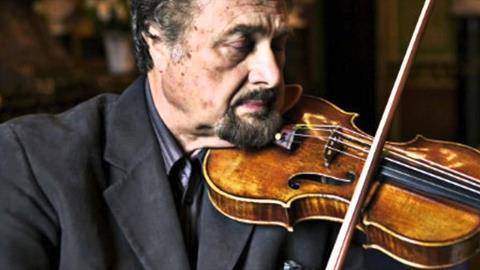There is no short cut to fine playing; only logical, intelligent and concentrated practice will yield results, writes the American violin virtuoso

When beginning a practice session, keep in mind that you have to warm up the fingers of both hands. You cannot begin by trying to regain the sound or facility that you had after three to four hours of practice the day before. There must be a warm-up period before you attack the repertoire or you can severely strain your hands.
In any physical sport, the muscles have to be exercised to perform well. This applies to your right hand as well as your left hand. The right hand makes the sound, and control of the bow requires coordination of arm, hand and fingers. It is interesting to note that Kreutzer Etude no.1 is devoted to bow control. This etude is often overlooked in present day teaching methods.
The left hand requires a reawakening process. Begin slowly with minimal vibrato and light finger pressure. The third and fourth fingers are the weakest and need more attention. Try playing a C major three octave scale using only the third and fourth fingers, and starting in the first position. Repeat this several times. Undoubtedly you feel some strain in your hand.
Now rest for one to two minutes and play an octave A on the G and D string in first position. Holding first and fourth fingers down begin a chromatic line with second playing B-Flat, B Natural, and third finger C Natural, C-Sharp, then begin the descending line keeping all fingers on the string. Repeat this using minimal vibrato to produce a nice tone and draw your bow without pressure from frog to tip. If your left hand feels fatigued again rest for a few minutes.
Now begin to exercise the trill. In first position, trilling with third and fourth fingers can immediately strengthen your hand. Start with B flat on G string (second finger) and trill with C natural. The trill establishes finger independence, so do not shake your hand with involuntary vibrato. This applies to trills in any position. Continue on D string starting on F and trilling with G, C and D on A string, and G and A on E string. Repeat this exercise using third and fourth fingers starting in first position on the G string with C natural and D, and move onto all strings.
Now I would recommend Kreutzer Etudes for trills. My personal favorites are numbers 18 and 21, but any etude from 15 to 22 would certainly prepare your hand to play anything. To this day I practice Kreutzer for the basic fundamentals of violin playing. I also work on Rode Caprices that are remarkable studies. Scales are also part of my practice routine and I do concentrate on one or two scales daily depending on the keys of the repertoire I plan to study.
Personally I prefer the scale system of Ysaÿe stemming from the Franco-Belgian School because it employs the second and fourth positions that are avoided in the German school. The fingerings eliminate a shift and I find it better for intonation.
I remember so well in the 1970s and 80s when Leonid Kogan and I were giving masterclasses in Nice at the Académie Internationale d'Eté, Kogan devoted all the time to playing scales and arpeggios; not permitting any other repertoire. Heifetz religiously practised scales for at least one hour a day. So I cannot minimise the effect of careful scale practice daily.
In my many years of teaching, I have found that students who do not progress rapidly, invariably do not apply logic and intelligence to their practice routine. Slow and repetitive practice is of course necessary. However, careful analysis is required for both hands.
For example, keep in mind what part of the bow is needed to facilitate the passage. In fast running notes, whether tied or rapid detaché, do not practise with vibrato. Calculate where in the bow it must be played when in tempo. Gradually build up to tempo, but again I must emphasise do not use vibrato. This is a bad habit that can mar your intonation when playing rapidly. Keep your hand still!
In a fast run, if after repeated practice it still does not go well, be creative. Try another fingering or change the bowing or concentrate on a note that may be a key to the running problem. But do not keep on doing what does not work and spending time needlessly. Learn to focus your thoughts and to not become robotic in your practice routine.
In a previous article about memorisation, I mentioned the photographic process that your eyes and ears play when practising. As quickly as possible, memorise the music and continue to practise until motor reflex sets in, and you can play it automatically without thinking of fingering note to note or up and down bow. Repeat this process the next day and continue until you can play it in your sleep.
Now the work really begins as you turn all of your attention to the music making. I can spend many hours on a page working to express with heart and mind the music as I want to hear it. Many fingering changes take place in trying to express a lyric phrase as one would sing it. First and foremost study carefully the composer’s intentions and apply good taste as to what is appropriate in the manner of bowing, fingering, and shifting.
Your ideas may change from day to day; in which case, you begin again to experiment with fingerings and bowings until you are satisfied with your result. Remember that every piece you play needs a different approach. Within the same work there are many moods that you must express with bowing textures, vibrato speeds, and inner feeling of style. You are like a fine artist who applies different colors to a painting to express an emotion; happiness, sadness, humour are present in every composition. It is your responsibility to express them as best as you can. To capture a mood that you feel is appropriate requires patient practice and experimentation.
Practising well requires complete concentration. Whether you are playing scales, etudes or a piece, at all times produce as beautiful a tone as you possibly can. Analyse carefully your bow distribution in slow as well as in fast music. Keep a good position and do not slump with the violin or with your left hand. Be patient because there is no short cut to fine playing. Becoming a great player requires devotion and love of music and the willingness to sacrifice thousands of hours to do it beautifully.
- Read Aaron Rosand’s blog for The Strad on producing a beautiful tone



































No comments yet